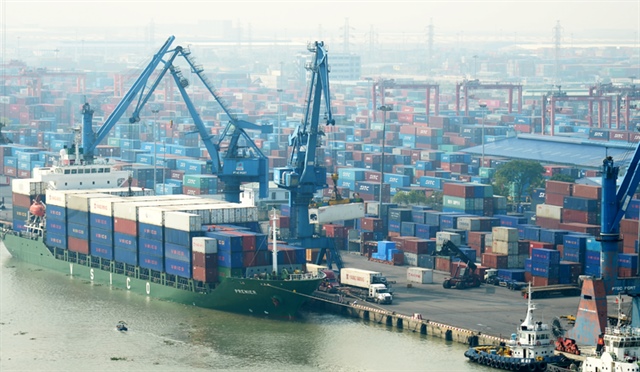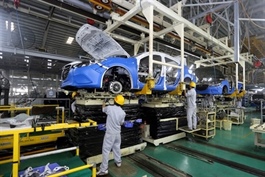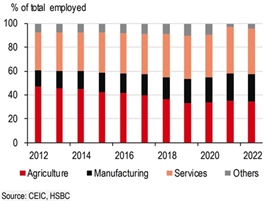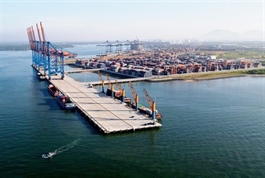Vietnam’s exports on recovery track
Vietnam’s exports on recovery track
Vietnam’s export growth is likely to accelerate further thanks to a favorable base effect in the last two months of the year.
Vietnam is experiencing a gradual recovery from the global trade slowdown, and exports are likely to accelerate as order volumes increase.

Dinh Vu Port in Haiphong. Photo: Pham Hung/The Hanoi Times |
HSBC's assessment was based on Vietnam's ongoing recovery from the global trade slowdown, with exports likely to continue gaining momentum on improved orders. In October, the data from the General Statistics Office showed that the country's merchandise export turnover amounted to approximately $32.31 billion. This represented a 5.3% increase compared to September and a 5.9% growth over the same period in 2022.
However, this recovery has been uneven. Out of the 34 major export categories, 15 experienced growth, driving the overall increase in exports in October. Consumer electronics (excluding phones) have rebounded, but the textile, garments, and footwear sectors continue to face declining order volumes.
S&P Global Market in its latest report noted that new orders for Vietnamese goods rose for the third consecutive month, reflecting improved customer demand. Nevertheless, this growth rate is relatively modest and among the weakest levels in the current growth period. Incomplete data suggest that customers remain cautious about committing to new orders.
Andrew Harker, the chief economist at S&P Global Market, pointed out that the current rate of growth in new orders isn't substantial enough to incentivize companies to ramp up production. Instead, businesses are using existing inventories to meet customer demands.
The S&P survey also highlighted a positive signal: the number of jobs has remained relatively stable, ending a 7-month decline. This suggests that businesses are preparing their workforce to meet the expected increase in new orders and production prospects for the coming year.
For the first ten months of the year, Vietnam's export turnover stands at an estimated $291.28 billion, a 7.1% decline compared to the same period last year. However, with the recent momentum observed in the past two months, HSBC predicts that export growth is likely to accelerate further, thanks to a favorable base effect in the final two months of the year.
This bodes well for a long-awaited recovery in the commercial sector and is expected to contribute to achieving a growth rate of 6-6.5% in 2024, according to the government's projection, and 6.3% as per HSBC's forecast.
This recovery is not limited to foreign trade. Following a slight improvement in domestic consumption during the third quarter, October retail sales continued to rebound, posting a 7% increase compared to the same period. Nevertheless, it remains slightly below the typical growth trend, and demand for consumer goods like cars continues to decline at double-digit rates.
Inflation has also started the fourth quarter on a positive note, with a minimal increase of 0.1% compared to September, bringing the year-on-year rate to 3.6%. This is below the Bloomberg (4.0%) and HSBC (3.9%) forecasts. HSBC believes that inflation risks are generally manageable.
HSBC's forecast suggests that inflation may rise to 4% in the fourth quarter (up from 2.9% in the third quarter) but should remain below the 4.5% ceiling. Next year, inflation is expected to hover around 3.3%. Although other countries in the region, such as Indonesia and the Philippines, are preparing to raise interest rates, HSBC doesn't anticipate the State Bank of Vietnam to follow suit, as inflation doesn't appear to be an immediate concern. Consequently, the operating interest rate may stay at 4.5%.
However, many manufacturing enterprises are feeling the pressure of inflation, as input costs and output prices are increasing at a faster pace. The inflation rate has reached an eight-month high.
The surge in oil prices is widely believed to be a contributing factor to rising input costs, affecting commodities like fuel and plastics. Additionally, the depreciation of the Vietnamese dong (VND) against the US dollar (USD) is adding further pressure to increase costs. To compensate, companies have significantly raised their selling prices.
|
Hanoi’s trading performance shows positive trends In October, both exports and imports showed positive trends. Total import-export turnover is estimated at $5.09 billion, up 2.1% month-on-month and 10.1% higher than in October 2022. During October, certain product categories had increased export turnover compared to the same period: Machinery, equipment, and spare parts rose by 5.3%; transport vehicles and spare parts saw a 12.2% increase; petroleum surged by 42.1%; agricultural products showed a 25% increase; other goods experienced a substantial 42.4% growth. In the first 10 months of 2023, the estimated merchandise export turnover was $13.8 billion, down 1.4% from the same period in the previous year. This included the domestic economic sector, which increased by 5.8% to $7.9 billion, and the foreign direct investment sector, which declined by 9.7% to $5.9 billion. Meanwhile, the estimated goods import turnover was $30.6 billion, down 9.5% compared to the same period in the previous year. Of these, the domestic economic sector posted a decline of 7.6% to $25.3 billion, and the foreign direct investment sector recorded a decrease of 17.9% to $5.3 billion. |























